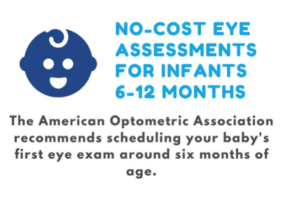Now EYE Know! – Pediatric Exams
Now EYE Know!
Why is it important for children to have eye exams?
 It is especially important for children to have eye exams. Kids with blurry vision often do not mention it or complain. Children with blurred vision think that is how everyone else sees the world.
It is especially important for children to have eye exams. Kids with blurry vision often do not mention it or complain. Children with blurred vision think that is how everyone else sees the world.
Much of a child’s learning is visual. Blurred vision may lead to difficulties in school or playing sports. Blurry vision is not the only reason to have an eye exam. Children could have difficulty using both eyes together, a critical reading skill, and you might not know. Undetected and untreated vision problems can elicit some of the very same signs and symptoms commonly attributed to attention deficit/hyperactivity disorder. A yearly comprehensive eye exam can help make the right diagnosis for your child’s needs.
Myopia (aka near-sightedness) has become one of the most common vision issues in children ages 3 to 13 due to an increase in the amount of time spent indoors and on digital devices. Myopia is often progressive. It puts children at risk for learning difficulty at a young age but also increases their risk for ocular disease later in life such as glaucoma, retinal detachment, and cataracts.
It is also possible for a child to have one eye that sees well while the other eye has a higher prescription. The blurry eye may become amblyopic or “lazy.” In these cases, their brain does not receive a clear image and won’t develop properly. When an eye becomes amblyopic, it will still see blurred images even with corrective glasses. Routine eye exams help identify problems like amblyopia to ensure both eyes are working well together and set children up for success!
 In addition to providing routine pediatric exams, Dr. Aslam is an InfantSEE® provider. Under this program, she performs a comprehensive eye assessment for babies between 6 and 12 months of age as a no-cost public service. She is so happy to see the youngest patients in our practice through this program and set them on the course for a lifetime of healthy vision. These exams are a great opportunity for new parents to ask questions about what to expect when it comes to their babies’ eyes and vision.
In addition to providing routine pediatric exams, Dr. Aslam is an InfantSEE® provider. Under this program, she performs a comprehensive eye assessment for babies between 6 and 12 months of age as a no-cost public service. She is so happy to see the youngest patients in our practice through this program and set them on the course for a lifetime of healthy vision. These exams are a great opportunity for new parents to ask questions about what to expect when it comes to their babies’ eyes and vision.
If you have any questions, feel free to ask Dr. Jennifer Aslam or Dr. Lara Priest.
Want more information? Click the links below to read more on some helpful websites.
Infant Vision: Birth to 24 Months of Age
School-Aged Vision: 6 to 18 Years of Age